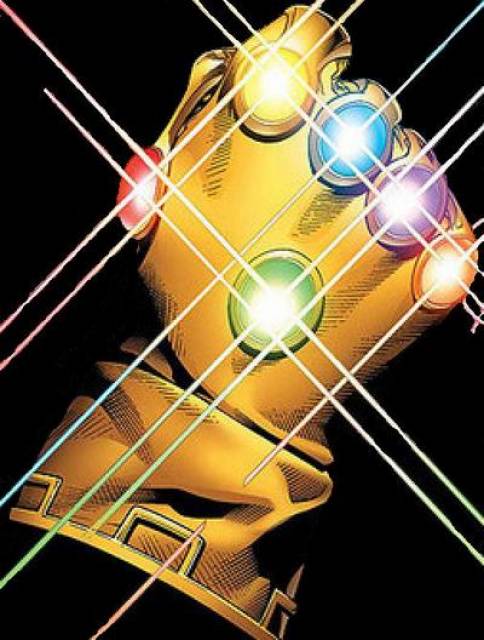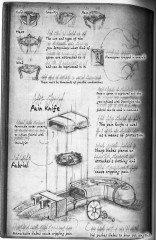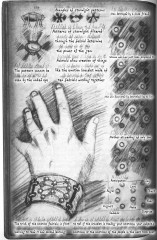Search the Community
Showing results for tags 'fabrials'.
-
Theory: Ancient fabrials operate with the help of a willing, sentient spren. "Modern fabrials" are Stormlight-powered mechanisms that make use of a spren trapped in a gemstone. All of the details aren't entirely clear. We know the type of gem and spen matter. Some of them, at least, require you to press metal against the gem. Mysterious as it may be to us, the scholars of Roshar have it pretty well figured out. And yet they are totally stumped by so-called "ancient fabrials". We've seen several ancient devices with all kinds of specific and powerful uses. Devices that use Stormlight like a fabrial... And yet they don't require a trapped spren, and the means to create more of them are unknown. Soulcasters. Shardplate. Oathgates. So what's the deal? I think that they DO use spren. Just in a very different way. I don't think I've seen anybody talking about this. Honestly, I didn't give it much attention myself until I was recently reminded about something I had noticed in Kaza's interlude when Brandon read it earlier this year. If you look closely, a spren seems to be present when she uses her Soulcaster. When we put this together with everything else we saw in Oathbringer... I think the solution of how ancient fabrials becomes clear. I'm going to go through all of the so-called ancient fabrials that we know of and see what observations we can make. Soulcasters Again, the big revelation here is from Kaza's interlude: See that mention of "another will reinforcing her own"? I think it's a spren. Notably, the spren is "attracted by her request for aid". Recall that trapping spren for modern fabrials requires you to attract the spren: Interesting that this spren is also "attracted". But it isn't a slave. It came willingly, to help. It's unclear whether this particular spren is "attached" to Kaza's soulcaster, or whether it was simply a spren that happened to be nearby. You could interpret this different ways. Did a particular spren, or a particular group of spren, agree to be bound to the soulcaster? Or to come at the call of a Soulcaster? Perhaps it's not an agreement binding them at all, but rather their nature. They hear a Soulcaster's "request for aid" and just naturally want to join in. What kind of spren could this be? I'm skeptical that it's a Knight Spren, though that's a possibility. I'm more inclined to think that it is some spren related Soulcasting OR some spren related to the essence of smoke (which Kaza's device is attuned to). And on that note, it's also interesting that we see there are different "levels" of Soulcasters--some being more limited than others. This theory perfectly explains why in one of two ways. (1) Perhaps the more powerful Soulcasters are linked to multiple spren, each granting different types of Soulcasting. (2) Or perhaps the more powerful Soulcasters are linked to more powerful spren--one that is able to do more than the spren of lesser Soulcasters. Oathgates Okay, that's a nice theory for Soulcasters, but is there anything to back this up? Let me introduce you to these guys. We now know that the Oathgates each make use of two strange and powerful spren. Exactly what they do is hard to say, but they are obviously part of the device's functionality. The fact that the device is a fabrial is also obvious--Shallan makes the observation when they first discovered the Oathgate in Narak. You charge it with Stormlight, point it the way you want to go, and activate it. The Surgebinder's own spren, of course, isn't what makes the thing work. It's more of a key perhaps? In any case, another example of an ancient fabrial that uses a spren to work. It's notable that (in this case) the spren seem to have made an agreement to guard/operate the thing. They follow specific rules and don't seem to leave their location in Shadesmar. Urithiru Our characters have begun to speculate that Urithiru itself is one GIANT fabrial. We know so little about it, so there's not much to say here... We DO know that it is mostly (but not entirely) non-functional. We can only speculate as to what it should be doing, but records left by former Radiants confirm the notion that it used to be MORE somehow. Plus there are the oddities like the massive gemstone pillar that won't be infused, the strata on the walls... It isn't fully broken of course. One record notes that the artificial air pressure hasn't failed, even if the "climate control" hasn't, and this apparently still true. What do we know about how Urithiru operated? About why it stopped working? One answer: the Sibling. A spren heavily connected to the tower city. A spren which many are speculating "IS" the city. It will be interesting to see what Jasnah finds when she investigates the city in Shadesmar... An oddity?.... Or an ancient (very powerful) fabrial, making use of an ancient (very powerful) spren? Shardplate I'm proposing that Shardplate is actually an ancient fabrial. The resemblance to other ancient fabrials is notable. It's an ancient, powerful device that is powered by Stormlight, it doesn't use a trapped spren, and it seems to make use of the Surges. The popular theory on Shardplate of course is that they are the "cousin-spren" of the Surgebinder's Nahel bond spren. This theory doesn't negate that possibility. In fact, it may fill in the gaps of why Shardplate is so different from Shardblades. Why does Shardplate behave so differently in modern times? Great question... For that, I'd have to turn attention back to Urithiru. We have that city as an example for what happens when an ancient fabrial has stopped working at full functionality. Perhaps the same is happening with Shardplate? Unfortunately our brief visions of "properly working" Shardplate are limited in what they reveal. How might it work? Presumably it's an actual, physical device of some kind (not, I would propose, the "dead bodies" of lesser spren) that happens to be tied to one or more spren. Perhaps it's tied to the cousin spren. Perhaps some other spren. Perhaps multiple. Perhaps one. It's hard to say. We haven't seen into Shadesmar in the presence of Shardplate, yet, so we don't know if this/those spren are present with the Plate. But then if the Plate is "asleep" like Urithiru and the Sibling it's hard to guess what we would expect to see. Conclusion I feel like I need a conclusion... I don't have proof for this theory, but the evidence is (I think) pretty strong and consistent. I left out Regrowth fabrials simply because we know almost nothing about them besides the fact that they exist. The inclusion of Shardplate is the most questionable piece, but I think it fits. As an aside, I suppose it's worth mentioning Jah Keved's half-shards. In Oathbringer Chapter 100, Taravangian suggests that the half-shards make use of "true spren". This is a controversial statement, but however you interpret his words, it suggests that these modern fabrials are more powerful because they make use of more powerful spren. That is, I think, in line what the concepts here. It suggests perhaps that the difference between a half-shard and Shardplate is a sentient spren which cooperates rather than a spren which is enslaved. There are a LOT of follow-up questions to be asked... How are they made? What's the nature of the "bond" (if one exists) between fabrial and spren? Is it the same for all or can it be different? What types of spren are used? I'll leave those conversations to the rest of you.
-
Fabrials Era 1 Fabrials- Fabrials of the Knights Radiant. These fabrials probably use sentient spren that agree to being connected to fabrials and are fabrials that store stormlight keyed to one of the surges. Era 2 Fabrials- Fabrials of current day Roshar. They use nonsentient spren. Types Altering Fabrials Augmenters- These fabrials are crafted to enhance something. They can create heat, pain, or even a calm wind, for instance. They are powered—like all fabrials—by Stormlight. They seem to work best with forces, emotions, or sensations. I am guessing that any one of the ten Polestones will work. Diminishers- These fabrials do the opposite of what augmenters do, and generally seem to fall under the same restrictions as their cousins. Pairing Fabrials Conjoiners- By infusing a ruby and using methodology that has not been revealed to me (though I have my suspicions), you can create a conjoined pair of gemstones. The process requires splitting the original ruby. The two halves will then create parallel reactions across a distance. Spanreeds are one of the most common forms of this type of fabrial. Conservation of force is maintained; for instance, if one is attached to a heavy stone, you will need the same strength to lift the conjoined fabrial that you would need to lift the stone itself. There appears to be some sort of process used during the creation of the fabrial that influences how far apart the two halves can go and still produce an effect. Reversers- Using an amethyst instead of a ruby also creates conjoined halves of a gemstone, but these two work in creating opposite reactions. Raise one, and the other will be pressed downward, for instance. These fabrials have only just been discovered, and already the possibilities for exploitation are being conjectured. There appear to be some unexpected limitations to this form of fabrial, though I have not been able to discover what they are. Warning Fabrials- Using an amethyst instead of a ruby also creates conjoined halves of a gemstone, but these two work in creating opposite reactions. Raise one, and the other will be pressed downward, for instance. These fabrials have only just been discovered, and already the possibilities for exploitation are being conjectured. There appear to be some unexpected limitations to this form of fabrial, though I have not been able to discover what they are. Sanderson, Brandon. Oathbringer: Book Three of the Stormlight Archive (pp. 1238-1239). Tom Doherty Associates. Kindle Edition. There are 2 more pairings of Fabrials that we don't know about. The Technological Plateu- Rosharan artifabrians have 5 pairings of types of fabrials, ten gemstones to manipulate the effects, and three type of different ways to harness the power of spren and the surges. Once they figure out how to create Era one Fabrials, they will be able to create many types of fabrials, but eventually the fabrials will eventually get too big for there the intended use. Rosharans can counteract this by controlling the size of spren, which we know can be gone from one of the interludes in WoR, to make them fit tinier gems. But they don't have the tools to cut gems that small and wire the gems and mechanisms together to create a fabrial. In the future, once they get past this problem what kind a fabrials do you think will be created, and how will it affect the many Rosharans? Fabrial Cities I think Fabrial Cities will become popular. I don't think we will have Urithiru cites due to lack of Super spren who would agree to this. Instead I think it will several to very many smaller fabrials will be interconnected to create one city fabrial. To do this, they will probably use a lot logic spren to handle all of the connections, stormlight infusion, and information exchanged. This also lets spren-hacking become a thing. Holograms and the Internet I think that these fabrials will probably use rubies and creativity and logic spren to provide near instant transfer of information. I don't now how they will keep information, but that might be able to work with one of the unknown pairing. For holograms I think it will be a mixed with creativityspren and maybe a hypothetical pairing to the warning fabrials, this could also work for screens for boards and communication devices.
-
It's hinted at in Oathbringer that the big pillar of gemstones in the library is part of a fabrial, or that the city itself is a fabrial. Is it unlikely that the spren in this fabrial was the Sibling? We know that all fabrials require a spren, and the Sibling is just another spren. Indeed, Re-Shephir has once been trapped in a gemstone, and at the end of the book Nargaoul is in the gemstone called King's Drop, which is a gemstone that doesn't lose stormlight and which the unmade supposedly would be incapable of getting out of. This idea has got to have some measure of accuracy. Also, the King's Drop brings up more questions: Must the gemstone be cut perfectly* for the spren inside to be incapable of escape, since other fabrials lose stormlight and their spren don't escape. * cut perfectly, meaning stormlight doesn't leek from it So if it wasn't the cut that mattered (which is still under debate, by the way), was it the size of the gem Dalinar needed? Because there were plenty of other gems around to use. What would a fabrial with that cut (and with Nargaoul inside) do? We know from Navani's notebook that the cut of the gem influences what the fabrial does. Are there multiple ways to cut a gem so that it doesn't leek? Could such a gem trap Odium without having to make an oathpact? And what does the Urithiru fabrial do anyway? The elevators seem to work independently of that. It's in the middle of the library, so that might be a clue.
- 9 replies
-
1
-
- stormlight archive
- stormlight
-
(and 3 more)
Tagged with:
-
So I was re-watching Back to the Future, as one does, and thinking about what a disappointment it was that we don't have widespread hoverboard use even though we should've years ago and I realized what someone needs to do is go to Roshar and convince either artifabrians or windrunners to create hoverboards since artifabrians could use reversers to make the hoverboard float and windrunners could half lash a board to the sky in order to make it weightless. The only problem would be getting the lashed board to move. But with a fabrial, you could make a controller of sorts that you can move around to make the hoverboard do the opposite.
- 4 replies
-
- stormlight archives
- hoverboards
-
(and 2 more)
Tagged with:
-
So just a quick thought about fabrials. In OB we see Navani create or at least commission a watch for Dalinar. The gauntlet has a watch, a high storm watch and a pain fabrial which will reduce or remove pain from the wearer. Later near the end of the book as Thaylen City comes under attack Navani reflects on the possible creation of a fabrial that will repel exhaustion. It has been implied; possibly confirmed, that fabrials are created by imprisoning a spren in a gemstone and powering it with stormlight. Sounds familar to me... dunt dunt duuuunnnnn The Infinity Gauntlet!! Powered by Soul Gems this is the ultimate BA fabrial. What combination of spren could be trapped to make the ultimate fabrial in the cosmere? Could glory spren combat exhaustion or depression? Is there growth spren for healing? So many possibilities. Last note concerning fabrials and this is actually a topic for a separate thread but what total dicks men are. Not only are we the void bringers but we enslave spren to make appliances!?
- 12 replies
-
3
-
- fabrials
- infinity gauntlet
-
(and 1 more)
Tagged with:
-
As I thought about Zahel, Azure, and Nightblood and their future roles in the stormlight archive it became increasingly obvious to me that Awakening would eventually take a bigger role in the story. Zahel is also known as Kalad the usurper former God-King of Hallandren and creator of an army of corpses encased in stone. Given that in roshar the dead are transformed into various metals it seems inevitable that Zahel will create another army. Ever since Nightblood appeared at the end of WoR the question of whether it would grant any abilities to it's weilder Has tantalized my mind. Azure came into Oathbringer wielding an awakened blade searching for Nightblood and let us know that Awakening was here to stay. So I set out to make a list of all the possible ways Awakening could interact with Rosharan magic. With awakening you take a piece of your soul called Breath and put it into an object with the right command giving it life. This Breath can be compared to spren, some of which are described as pieces of the gods. The eighth heightening of Breath has the ability of "Command breaking" I am speculating that this would allow you to alter the Intent on certain lesser spren similarly to San-want. In the cosmere it is hard to know for certain because only the God-kings have reached that heightening. So number 1. Creation of more shardblades. This is the easiest to speculate because the spren do express an interest awakened blades in Oathbringer. Number 2. Using breath instead of spren in fabrials. Number 3. Use of the eighth heightening to corrupt a spren possibly resulting in the ability to convert stormlight into breath. Similarly as Sja-anat corrupting Glys gave Renarin access to visions of the future and possibly voidbinding. Number 4. Using the eighth heightening to convert stormlight into breath. Number 5. Nightblood spren. This might be the most terrifying concept in the cosmere, spren who imitate the Ideal of Destroy Evil. Number 6. New forms for the Singers. I saw another thread mention this one, basically you put breath in a gemheart to create a new form or alter existing ones. It is worth noting that any magic system that replicates another will have some differences an example being the fused and the knights radiant. I feel there is more that can be done with Awakening and Surgebinding so If you think of anything I would be glad to read it.
- 6 replies
-
2
-
- warbreaker spoilers
- nightblood
-
(and 2 more)
Tagged with:
-
Spoilers up to Part 4. I think it's possible that Soulcasting, while it might slowly deteriorate your physical form, slowly changes your cognitive form until you become a Spren. (One to match the type of Soulcasting done) When I read Kaze Interlude, I thought she was just slowly turning into smoke. Of course, she soulcasts matter into smoke, so it seems like a plausible consequence. Chapter 105 talks of an ardent Soulcaster whose "skin beneath was colored like granite, cracked and chipped, and seemed to glow from within." This description matches that of some of the spren walking around in the Spren port in Shadesmar. This made me realize that there was also a Spren to match Kaza's trabsformation in that town. There were smokespren there as well. Anyone have a similar thought or theory about the end cost of Soulcasting?
- 6 replies
-
4
-
- soulcasting
- oathbringer
-
(and 3 more)
Tagged with:
-
I don't know if there is a WoB on this yet, but I wasn't able to find one. Are the Conjoiner spanrials (spanreeds and other fabrials that function by creating identical effects across distances) limited by the speed of light? The speed of light imposes a limit on how fast information can be transmitted. So is it possible to transmit information faster than the speed of light using a spanrial?
- 15 replies
-
Fabrials are the third magic system on Roshar There should be 10 types of fabrial Brandon's also said that Roshar could be considered to have 30 magic systems. We know there are 10 Surges, and the Ars Arcanum mentions “the ten levels of Voidbinding”. So that leaves 10 forms of the third system, Fabrials. The known types The Ars Arcanum mentions five fabrial types: Augmenter, Diminisher, Conjoiner, Reverser, Alerter. The Augmenter/Diminisher and Conjoiner/Reverser are paired; the Alerter doesn't seem to have a counterpart. Navani unveils a sixth type near the end of WOR, the Attractor. New types Just as how Surges come in pairs, I'd suggest that fabrial types are inherently paired. So we can speculate on the counterparts of the two “unpaired” known types. The opposite of an Attractor would be a Repeller. Could be used to keep things dry, drive away pests or mold etc., or maybe deflect arrows. The opposite of an Alerter might be something like a “Jammer”. This might not just block Alerter Fabrials, but also stuff like Spanreed communication. That leaves two types totally unknown. EDIT: By "proper" fabrials I mean the things Artifabrians make. Not the "ancient fabrials" like Soulcasters, Oathgates, Shardplate.
-
Thinking about this epigraph quote: The word 'bind' suggests this isn't something like a Shardblade, a weapon in the normal sense. It sounds more like how spren are trapped in a fabrial. Now, there doesn't seem to be any way to bind 'mortal' people or animals into a fabrial, but this quote seems pretty mythified given the "steps crafted for Heralds, ten strides tall apiece" - we know that Heralds are actually normal-human-sized. So maybe the Dawnshards are a vague, mythical memory of a fabrial that could trap either normal or void spren - with the 'normal' spren being turned into "mortal creatures" as the details were forgotten? Alternately, maybe the Dawnshard created a two-way bond -- maybe it was something like a Meta-Fabrial that could create and control bonds between spren and Physical realm life. The Ryshadium don't seem to be true Roshar natives, yet they have inherent spren bonds - maybe they were created with a Dawnshard.
- 2 replies
-
1
-
- dawnshards
- fabrials
-
(and 1 more)
Tagged with:
-
For some months now, I’ve been working on creating a framework for all of the magic systems of Roshar that combines everything we know about them and makes predictions for that which we don’t know. This topic is the end result. Since I’m aiming for completeness, there will be things here that are already well understood, as well as things that I haven’t seen proposed before. So, with apologies for the sheer length that it has become, allow me to present my framework. Magics by Shardic Composition Let's start by listing the various Rosharan powers and classifying them by the Shards which power them. Magic Shardic Composition Surgebinding Honour & Cultivation Ancient Fabrials Honour & Cultivation Modern Fabrials Cultivation Old Magic Cultivation Voidbinding Honour & Odium Voidbringer Powers Cultivation & Odium Surgebinding My classification of Surgebinding shouldn't be raising any eyebrows since it is well understood that each type of Radiant spren is some mix of both Honour and Cultivation. However, let's take a moment to consider how the two powers manifest in Surgebinding as this will provide insight into how I've classified the other magics. While there are many different interpretations of honour, they ultimately all come down to the interaction between two or more people: in a universe with only one person, it would be impossible for them to act honourably (nor to act dishonourably), for there would be no one for them to act honourably towards. This duality is reflected, I believe, in Honour's magic. The most obvious example of this would be the necessity to bond spren in order to perform it. Now, you could argue that since the listeners were bonding spren long before the Shards came to Roshar, this would mean that bonding spren is not related to Honour specifically. However, the listener bond is, by its very nature, very different to the Nahel bond; seemingly less a mutually beneficial partnership, and more a natural process. I would contend, therefore, that this is an example of Honour incorporating this aspect of the Rosharan environment into his magic out of necessity. I do not think that this idea of duality is limited only to the bonding of spren, however; I think that it extends even to the way that the powers form. You likely noticed that in my listing of the various magics that there is no system that is entirely of Honour. I think that Honour's nature means that he requires a second Shard to mix his power with in order to form a magic system. In other words, it would not be in his nature to form a magic that is purely his own. Another example of Honour's effect on Surgebinding is in its structure: the way that Surgebinders are divided up precisely into distinct predetermined Radiant Orders based off of their interpretation of honour, and their determination to emulate that ideal. And also, the way that the powers are divided up between the different orders. This is a rigid and inflexible framework, much like the Radiant’s Ideals can be. In short, this is where the "binding" in Surgebinding comes from: Honour is bound to another Shard and the Radiants to their spren, their Orders, and their Ideals. So if Honour provides a structure to Surgebinding, what does Cultivation provide? I think that it is through Cultivation that Surgebinders get to manipulate the Surges. If we look at the spren associated with each of the Shards, Honour's spren are those of emotion, again linking back to human interaction. Cultivation's spren, however, are the spren of nature, so it makes sense that it is Cultivation's power that gives access to the natural Surges. Now, I can imagine it being argued that since on Scadrial, all the magic systems revolve around metals, surely all the magic systems of Roshar should likewise revolve around the Surges, not simply the ones associated with Cultivation. However, I would argue that this is a false analogy: the metals on Scadrial act as a focus, the Surges on Roshar do not. The powers produced by the Metallic Arts (with the exceptions of Allomantic iron, steel, aluminium, and chromium) are not related to metal themselves. Therefore, whilst all of the Rosharan magic systems should share a common focus, it should not necessarily be the case that they all share the Surges. Modern Fabrials Now with that established, it should be obvious why I think that Fabrials are a magic system purely of Cultivation. They lack the rigid structure that I have associated with Honour, and while the spren are still part of the magic, they are trapped inside the gemstones rather than working with the user as you would expect in Honour’s magic. This leaves Cultivation as the only reasonable candidate, which in turn means that they must be utilising the surges in some way. Although, without the rigidity of Honour’s framework, the way they manifest is apparently quite different. Ancient Fabrials The first thing to note here is that these fabrials do not seem to have much in common with modern fabrials, to the point that I suspect that calling them fabrials at all is a misnomer. Modern fabrials all function by trapping a spren in a gemstone, ancient fabrials do not appear to do this. Spren are clearly involved in some way, just as they are in every other magic; we in fact see this in the operation of the Oathgates. In order to activate them, you need a Shardblade, i.e. the physical manifestation of a spren that is part Cultivation and part Honour. Moreover, the spren needs to be alive. This implies that the person operating the Oathgate needs to be working together with the spren, which sounds just like an Honour based magic. This would mean that the ancient fabrials are far more closely related to the Surgebindings than they are to modern fabrials. Which makes sense given that the effects we have seen (Soulcasting, Regrowth, Transportation) appear to be the same as various Surgebindings. In fact, when Nale heals Szeth with one of these ancient fabrials, he actually refers to it as a Surgebinding. Ideally I would compare the operation of the Oathgates to that of other ancient fabrials, unfortunately though, we haven’t really seen enough of these yet to be able to draw anything meaningful from them. The Old Magic This isn’t a magic like others on this list: it's not something that people can perform; instead, it seems to be practised solely by the Nightwatcher, about whom the only things we can really say with confidence are that she is some kind of “mega-spren”, closely related to Cultivation. This would suggest then that the Old Magic can be described as similar to a sapient, self-operating fabrial. I don’t think that there’s much more that can be said at this point without additional information about the Old Magic or the Nightwatcher. Voidbinding This brings us to the only magic system on the list which I believe to be unrelated to Cultivation. If we look at the Voidbinding chart from the back of The Way of Kings, it is immediately obvious that the structure of the magic is the same as Surgebinding. It even has "binding" in its name, hence why I think that it is of Honour. However, if we look at the symbols where, on the Surgebinding chart, the Surges are placed, we see not the symbols for the Surges, but a twisted version of them. Hence I do not think that Voidbinding will be related to the Surges at all, and hence Cultivation has no part in Voidbinding. Voidbringer Powers And finally, we come to the powers that were demonstrated at the end of Words of Radiance by the Voidbringers. Why do I think that this isn't Voidbinding? We have a WoB that we haven't seen Voidbinding yet, but we have seen these powers, therefore they must be something different. Additionally we have the following WoBs: Since the Voidbringers are forms of the Parshendi, and the Parshendi are not of Honour, if my classification of Voidbinding as being of Honour is correct, then the Voidbringers cannot be Voidbinders. So, why do I think that the Voidbringers are related to Cultivation rather than purely of Odium? If we have a look at Dalinar’s vision of the Purelake, we see him looking for a voidspren, which ultimately ends up animating a thunderclast. The voidspren is described to him as: “A spren that doesn’t act like it should”, not as a new type of spren. And apparently this is a result of the spren interacting with Sja-anat, an Unmade. What’s more, the spren they end up chasing has a resemblance to a riverspren, a type of nature spren, which is therefore related to Cultivation. I would propose, therefore, that the Unmade corrupt spren to make voidspren. When the spren was originally of Cultivation they go on to form Voidbringers and thunderclasts and the like. And when the spren was originally of Honour, they will bond to form Voidbinders. On Initiation The first thing to note here is that not all magics require an Initiation in order to be used. Some, such as Haemalurgy, are universal and can be used by anyone. Modern fabrials also seem to fall under this category. In order to use a magic, you need three things: intent, Investiture, and a focus. In the case of fabrials, the Investiture and the focus are both incorporated into the device itself. In other words, the user only needs to provide the intent to use the fabrial in order for it to work. The crucial part here is that the user does not need to access an external source of Investiture themselves: the fabrial does that for them. The Old Magic is not relevant to this discussion since it is restricted to the domain of the Nightwatcher. Also, I don’t think we’ve seen enough of the ancient fabrials yet in order to determine whether they would also be universal or not, so, for the time being, I’ll pass over these two magics. The remaining magics all seem to require Initiation. Khriss’ comments on Initiation in Elantris’ Ars Arcanum suggest that the method of Initiation across all of the magics on any given world is consistent. I think it should be fairly obvious, therefore, that the method of Initiation here is the spren bond. All of the remaining magics utilise a spren bond in some form, and Syl has openly admitted to Kaladin that she is the reason that he is able to Surgebind. On the Rosharan Focus So far I’ve seen theories on the focus claim that it’s either the gemstones, or the spren, or the spren bond. Firstly, I don’t think that it can be the spren bond: I have already demonstrated that it is the method of Initiation and I don’t see how it can be both. Also, as previously noted, not all magics require a spren bond, but all magics require a focus which is consistent across all Rosharan magics, therefore if the spren bond were the focus, this would be a contradiction. Things get interesting when we start to examine the spren and the gemstones as candidates for the focus, however. When examining Soulcasting, the gemstones act exactly as you would expect the focus to, the type of gemstone used determines the result of the transformation. However, this does not appear to be the case with any other magic that we have seen, which should mean that the gemstones can’t be the focus. The spren seem like an ideal candidate for the focus since they are, like the gemstones, present in some capacity in all Rosharan magics. Moreover, as they are capable of changing their form at will, if they are the focus then they should be able to direct the form that the power takes by themselves. And, we saw in the climax to Words of Radiance, Syl was able to accurately determine the weapon that Kalaldin wished her to form without him having to actively communicate it to her, it would follow then, that the Radiant spren could do the same thing to provide their Radiant with the power that they wished to use. And since in modern fabrials, the spren would presumably be trapped in a single form, it would account for why fabrials each have only a single function. There is, however, a problem with using spren as the Rosharan focus, and it is essentially the same problem that we ran into when we tried considering the gemstones as the focus: when considering Soulcasting, it is clearly the gemstones, not the spren that is determining the result of the transformation. So both the spren and the gemstones must be the focus, but neither the spren nor the gemstones can be the focus! To resolve this, I think we’re going to need to take a closer look at what a focus actually is. To start off with, I don’t think that a focus is actually physical. Everything in the Cosmere exists to some extent across all three Realms, so that we might be able to see or interact with it in the Physical Realm does not mean that this is where the magical interaction is happening. If we look at AonDor, the focus like in all Selish magics is shapes, however, an Aon will continue to function even if you were to destroy its physical representation. Indeed Elantrians can draw Aons in the air, which shouldn’t have a physical body at all. And of course, on Nalthis, they use Commands as a focus which, being auditory, likewise shouldn’t have a physical body. I suspect that it is in the Cognitive Realm that these gain a more concrete, not to mention, permanent, form. So, Investiture flows from the Spiritual Realm to the Cognitive Realm where it interacts with the focus and is filtered down into the Physical Realm in the form determined by that focus. But, if the focus is cognitive, then shouldn’t it be possible for it to be something more abstract in nature, such as a function? We know that gemstones and spren have some kind of relationship with each other. Just consider Navani’s notebook: Could it be the case that spren and gemstones are bound together as variables in a cognitive function that is acting as the focus on Roshar? When spren are imprisoned in gemstones, is that what’s really happening, or are they instead being constrained to the same space as part of such a function? This is what I think is happening here: neither the spren nor the gemstone is the focus, but they are both components in a kind of complex focus. How the Honourblades Work So, I’ve been repeatedly coming back to the idea that the spren are involved in some way in every magic on Roshar, yet you might have noticed that the Honourblades are an exception to this. They allow their wielder to Surgebind, but they are not themselves spren. In fact, originally, the Honourblades would power Surgebinding by opening a direct conduit to Honour, similar to how Allomancy opens a conduit to Preservation, meaning that even gemstones wouldn’t be needed to provide Stormlight. Thus, the Heralds might not have needed either part of the focus that I specified above. Does this not contradict my argument for the focus? I don’t think so; I think that the way Honour hacked the magic in the Honourblades means that this isn’t an issue. When Preservation hacked Allomancy so that Vin was able to burn the mists, she no longer needed the metals for Allomancy. And similarly, when Vin became Preservation, she was able to power Allomancy for Elend without him having access to the metals. Based off of this, I think it’s clear that a focus is not required when a Shard directly intervenes like this. One final point: it could perhaps be argued that the Honourblades represent the true form of Surgebinding and that the Nahel bond is the true hack since the spren copied the Honourblades. I disagree with this interpretation, though. I think that the Radiant spren have always been able to form the Nahel bond and create Surgebinders since Honour first Invested in Roshar, they simply didn’t know that they could do this. When Honour hacked the system by creating the Honourblades though, the spren were able to figure out that they had this ability from seeing what the Honourblades could do. TL;DR Given the size and scope of this treatise, it is impossible to easily summarise the entire piece, however, a few key points are as follows: Honour’s influence causes a magic to take on a predefined, rigid structure. Voidbinding does not manipulate the Surges at all. Spren Bonds are the basis for Initiation. Roshar has a complex focus which utilises both spren and gemstones as components. The Honourblades negate the need for a focus.
- 42 replies
-
13
-
- realmatics
- spiritual
- (and 13 more)
-
In the first Eshonai interlude in WoR, we get this line: Have we ever had any confirmation on whether exposure to Stormlight directly encourages growth, or whether the Parshendi are using a growth fabrial? If it's the former, it might relate to stormwater being better for plants than regular water. Some sort of response to the Investiture.
- 12 replies
-
- words of radiance
- stormlight
-
(and 2 more)
Tagged with:
-
I'm not going into any great detail here... Just wanted to throw out the idea. One of the most popular theories for Shardplate is that it's a product of the "cousin" spren of each Order. (see windspren seeming to surround/defend Kaladin when he fights Szeth) The biggest holes with this theory are (1) why did they "die" or "freeze" in a similar way that the nahel spren did and (2) why do they need to be charged with gems/Stormlight? Shardplate seems to be more like a fabrial than anything else--a manmade device that uses trapped spren and runs on Stormlight. But they certainly seem to be MORE than a mere fabrial. Especially from the way they seemed more "alive" in Dalinar's flashbacks. So what if we mashup these two ideas together? What if Shardplate is a fabrial where the spren are more like a partner than a prisoner? Perhaps rather than capturing spren to make fabrials, the Radiants just sort of naturally attracted these spren into a symbiotic relationship of sorts. Not terribly different from the way spren interact with creatures on Roshar, when you think about it. And the result, when you have spren who are "willingly" working with you, is something more powerful and alive.
- 9 replies
-
5
-
- shardplate
- spren
-
(and 1 more)
Tagged with:
-
Hello Everyone, I think I cracked the code of the Fabrial Endsheet Table(Now I'm certain it's the Fabrial Table)! It is possible that someone else already did it, for which I apologize and hope that I might bring some more insight on his theory. Of course, we need more canon fabrials, which we can examine with their proper gemstone types, but this is for now. EDIT: Resources for viewing in the spoiler tag. Rule Number 1: When you look at the table, imagine that the glyphs of the Orders are actually the glyphs of the 10 Gemstones. Each Gemstone is corresponding to that Order's Gemestone from the Ars Arcanum Table. From now on, when I say Amethyst, you look at Willshapers in the Table. When I say Ruby, you look at Dustbringers in the table. And so on. There are no Orders here, only Gemstones. Rule Nubmer 2: Amethyst and Ruby are opposite, and that is further indicated by the lightning bolt. In other words, this way we can actually check in the table, which Fabrials are Pairing Fabrials: Conjoiners are sensitive fabrials. They are created by splitting one gemstone - specifically, a ruby - which will in turn act as a whole, with the actions of one half affecting the other half. The most common example of this type of fabrial is the spanreed by which means communication can be affected over a vast distance. Reversers act in the opposite way to conjoiners and are created by the splitting of an amethyst instead of a ruby. The reaction of each half is the exact opposite of what one half undergoes; to lift up one half would cause the other half to be forced downwards. As you can see, both Gemstones have exactly the opposite effects. Altering Fabrials: Augmenters are fabrials which enhance something. They can be used to increase heat or movement, to warm a room or generate a breeze. The Half-Shard shields invented in Jah Keved are an example of an augmenting fabrial. Diminishers are fabrials which work opposite of Augmenters. They are used to reduce something, such as pain or heat. The device used by Navani to reduce the pain in the wrist of her nephew, Adolin, is an example of this type of fabrial. Again, we have Fabrials that work the opposite, but this time, as you can see, nowhere is mentioned that the Gemstones are split in two halves like in the Pairing Fabrials. Unfortunately, it is not mentioned in the books what type of Gemstones are used for the Painrial, Half-Shards and etc. If I remember correctly, the heating fabrial is with Ruby, but please correct me, as I can't open the book at the moment. That leads us to the next Rule. Rule Number 3: There seem to be two very important rules in creating a Fabrials: 1. Discover how to cut the Gemstone. 2. Discover the type of Gemstone for the desired effect. Rule Number 4: Some Gemstones have more pairs/opposites from other Gemstones, as you can see in the table. Sapphire -> Smokestone, Diamond, Garnet, Heliodor. Smokestone -> Sapphire, Zircon, Ruby Ruby -> Smokestone, Amethyst, Diamond Diamond -> Sapphire, Ruby, Topaz, Emerald Emerald -> Heliodor, Diamond, Garnet Garnet -> Emerald, Sapphire, Topaz, Zircon Zircon -> Garnet, Smokestone, Amethyst Amethyst -> Zircon, Ruby, Topaz Topaz -> Amethyst, Garnet, Diamond, Heliodor Heliodor -> Sapphire, Emerald, Topaz Rule Number 5: I believe, the Ars Arcanum Table is quite important in this, because the water-attracting fabrial is powered by Garnets, which are connected to Blood, all non-oil liquid. Attracting Fabrials: These devices were demonstrated in Words of Radiance. Navani used water-attracting fabrials powered by garnets to keep bowstrings dry during the battle against the Stormform Parshendi. Mraize also owns one of these, powered by a smokestone, to draw smoke through his chimney. Given the way most fabrials seem to be paired by their effects, repulsing fabrials are likely possible as well. By following the Pairs rule, we can get a Gemstone that instead of drawing Smoke and Gas, it would release Gas. Rule Number 6: It proves what Brandon Sanderson is smirking and saying around that one magic system doesn't really mean only 10 types of powers (Like Surgebinding), but more types and variety. Imagine the possibilities. Final note, we know that Sanderson classified the Magic System as 30 types. That leaves us with 10 types of main Fabrials, each with subtypes depending on the type of Gemstone. This is pretty much a rough explanation of the Fabrial Magic System. I leave the imagination to you, as I am a bit wasted by trying to explain all of this at once. Please, ask any questions and critizise. Side Note
-
At the February 25 Austin signing for Calamity, a questioner asked Brandon, “How many magic systems are in The Stormlight Archives, and how many of them [have been seen?]” Brandon’s answer: I would say the only major one you haven’t seen is Voidbinding, it depends on how you count them. I count fabrials as one, Surgebinding as one, and Voidbinding as one. And then the Old Magic is kind of its own weird thing. This is Brandon’s most definitive statement (that I’ve seen) regarding Roshar’s magic systems. Let’s look more closely at what the three systems have in common and why the “weird” Old Magic doesn’t fit with the other three. I’ll then address the peculiar features of each system. Common Features Each of these magics (other than the older non-spren fabrials) rely on spren for their efficacy, including the Old Magic. The three “systems” all use the same “powers of creation” in some fashion. They differ from one another only in how the system gives access to and expresses the powers. The Old Magic in contrast seems to use only a few of the powers of creation, if any, which differentiates it from the “systems.” Brandon has said the powers of creation are just “tools” (emphasis added): [T]he powers granted by all of the metals—even the two divine ones—are not themselves of either [Ruin or Preservation]. They are simply tools. And so, it's possible that one COULD have found a way to reproduce an ability like atium's while using Preservation's power, but it wouldn't be as natural or as easy as using Preservation to fuel Allomancy. The means of getting powers—Ruin stealing, Preservation gifting—are related to the Shards, but not the powers themselves. I interpret this statement to mean that magic systems wherever located differ only in “the means of getting powers” and how the powers express themselves. How do each of Roshar’s magic systems differ? Surgebinding We know that the essence of Surgebinding is the Nahel bond. That is the “means” by which Surgebinders “get” the ability to use the powers of creation, which on Roshar are called “Surges.” Q: The ten Surges on Roshar, I think you said are basically a different set of laws of physics. A: Yeah. Q: Are those laws of physics consistent throughout the Cosmere? A: Um, y-y-yes, to an extent. You would consider, like - it's kind of weird because I based them on the idea of the fundamental forces, but this is kind of like a human construction. Like you could say that physics is pure and natural, but we're still putting things in boxes. And the scientists on Roshar would for instance consider being able to travel between the Cognitive and Physical Realms as a force, the thing that pulls people back and forth between that, as a fundamental force. I don't know if it would fit our definition of a fundamental force. That statement is also from the 2/25 Signing. IMO the reason the Nahel bond gives a Surgebinder access to the Surges is because the bonded spren is cognitive investiture. The bonded spren uses its mind to direct the Surges it controls as the Surgebinder requests. The Surgebinder thinks what he/she wants to do and the spren does it. Forum consensus (but not canon) is that Honor and Cultivation combined their investiture to create the Surgebinding system. This is an example of what Moogle calls “intent-meshing,” but what I call “mandate-meshing” since I think “mandate” is the textually proper word for what we’ve been calling “intent.” (See the HoA Chapter 79 Epigraph.) Honor’s mandate is “to bind,” as Syl tells us. Honor’s investiture creates the Nahel bond. But the bonded spren are a mix of Honor’s and Cultivation’s investiture. The two exceptions IMO are Bondsmiths’ spren (the Stormfather, Honor’s Cognitive Shadow comprised of pure Honor investiture); and Truthwatchers’ spren (pure Cultivation investiture, though connected to their KR’s SpiritWeb by Honor’s Nahel bond). I base my conjecture on the fact that these are the only two Orders “inside” the KR Order Chart (what I call the “Round Table”) that appears on the front endsheet of WoK. Argent has asked the question, “out of the potentially hundreds, if not thousands of spren types, why do the Radiants bind with only ten?” I believe the answer is that the ten spren types who became Radiantspren imitated the Honorblades. Each Honorblade is capable of two Surges. Only spren capable of exercising the same two Surges as each Honorblade - IMO the right mix of Honor's and Cultivation's investiture - would bond with KR. Other spren would have a different mix or be something else entirely. Those spren couldn't exercise the same Surges as the Honorblades. They cannot be Radiantspren. Fabrials There are two broad types of fabrials – the modern fabrials mentioned in the WoK and WoR Ars Arcana and ancient fabrials that seem not to rely on spren at all. We’ve seen two examples of ancient fabrials – ones that enable Soulcasting and Regrowth (the Transformation and Progression Surges). We don’t know whether the fabrial “magic system” includes both modern and ancient fabrials or one or the other. Brandon has said that “Fabrials can replicate all of the Surgebinding abilities.” Arguably the Honorblades themselves are non-spren fabrials that grant the ten Surges. The Oathgates are another ancient fabrial, but they require a “living” Shardblade – a spren; these may be more akin to modern fabrials, but maybe not. All fabrials of whatever kind require Stormlight to operate. The WoR Ars Arcanum author, believed to be Khriss, is “more and more convinced that [modern fabrial creation] requires forced enslavement of transformative cognitive entities, known as ‘spren’ to the local communities.” Note that Khriss confirms that spren are comprised of cognitive investiture. Modern fabrials lock the spren into specific types of gems. The color, cut and size of the gems appear responsible for attracting the spren, its imprisonment, the amount and “wavelength” of Stormlight the spren gain access to, and/or the type of magical output the fabrial creates. Khriss categorizes fabrials into five “groupings”: Altering (Augmenters and Diminishers), Pairing (Conjoiners and Reversers), and Warning. Fabrials “appear to be the work of dedicated scientists, as opposed to the more mystical Surgebindings once performed by the Knights Radiant.” While Khriss seems to write the Ars Arcanum contemporaneously with WoR events – she knows of the Jah Keved half-Shards, a recent development – she seems ignorant of the KR’s re-emergence. IMO the two distinguishing features of modern fabrials are the use of gemstones to capture spren and reliance on merely sentient spren. Surgebinding uses the more heavily invested sapient Radiantspren for its magic. “Altering fabrials,” for example, “seem to work best with forces, emotions or sensations” like heat, pain or wind. We know that sentient spren have access to the Surges too: windspren, for example, can use Adhesion to trip people. I also believe that whatever spren is imprisoned in spanreeds gives the users access to the Transportation Surge: the writing is “transported” over distance. Voidbinding There’s been some excellent speculation about Voidbringer magic, most notably on this thread begun by Argent. Brandon’s 2/25/16 statement clarifies, however, that listener Stormform cannot be “voidbinding,” since we HAVE seen that magic. Lightflame in that thread suggests that listener Stormform is Voidbringing, since that form enables the listeners to summon the Everstorm, the phenomenon that will “bring the Void.” Lightflame distinguishes Stormform from the “Voidish Forms” that Argent lists as the believed counterparts of the KR Orders: Nightform, Decayform and Smokeform. As Lightflame notes, these forms are mentioned in the listeners' Song of Secrets. Stormform by contrast is mentioned in the listeners Song of Winds. Stormspren’s ability to cause lightning and violent winds appears innate, like windspren’s Adhesion ability. Neither seems to require Stormlight. There's no need to replicate the discussion on Argent’s thread, linked above. Instead, if you’re interested I suggest you read the entire thread, since the posters there have helpful insights. It’s clear (to me) that Voidbinding resembles Endowment’s reincarnation of the Returned more than any other magic system we’ve seen. Voidbinding in all its known forms relies on the powers granted to/by the Unmade, the listener “gods.” These former listeners are remade by Odium’s investiture. Nightform: “as the gods did leave, the nightform whispered…” (WoR Chapter 23 Epigraph). Decayform: “a form of gods to avoid, it seems…” (WoR Chapter 24 Epigraph). Smokeform: “Crafted of gods, this form we fear. / By Unmade touch its curse to bear…” (WoR Chapter 31 Epigraph). Oh well, all my theories about “Voidbinding” being a combination of Honor’s and Odium’s investiture – Honor “binding the Void” – are now out the window… The Old Magic But I still have hope for this one. Also at the 2/25/16 Event, Brandon and a questioner had the following exchange: Questioner: I kind of envision the Old Magic working a little bit like Hemalurgy, where some[one] takes a part of the Physical DNA of the person and transmutes it onto the Cognitive DNA because everything seems to be a Cognitive shift for the person. Am I thinking along the right lines? Brandon: You are thinking along very-- Yes you are thinking along the right lines. I won’t tell you exactly but you are thinking along the right lines. I hesitate to infer anything from such a squishy answer. (And PLEASE future questioners, do not invite such an answer by building it into your question, as this person did. It probably wouldn’t have made a difference, but it’s best not to provide Brandon with an “out” in advance.) I’ll assume that the “right lines” the questioner was “thinking along” refers to a quasi-hemalurgical connection between two entities affecting one’s Cognitive capacity. Brandon’s answer conveniently parallels my theory that the Nightwatcher – purveyor of the Old Magic – is a combination spren consisting of the Cognitive investiture of each of Cultivation and Odium bound to one another by Honor: Cultivation boons and Odium Cognitive curses. As Brandon says in the opening quote of this post, the Old Magic is “weird.” You can read my theory and its many detractors, so I won’t repeat it here. In summary, the Nightwatcher is the Cognitive element of Odium’s imprisonment in Greater Roshar. Conclusion That’s all, Folks! Enjoy the rest of your weekend!
- 12 replies
-
15
-
- magic systems
- surgebinding
-
(and 4 more)
Tagged with:
-
Ok, I admit, the title is not serious. But my theory is. I am proposing that artifabricians may be using the Rhythms to trap spren in gemstones. To arrive to this hypothesis, I must first state what took me to the conclusion that traping spren in gemstones is a more complex procedure than finding the right gem type and cut. The indication lies in the Ars Arcanun: "The methods of their creation are carefully guarded by the artifabrian community" If one could discover such methods by simply bashing spren with different gemstones based on the ones found in fabrials, there wouldn't be much point in guarding such secrets. However, the listeners discovered how to store spren for later transformation after hearing from humans that it as possible to trap them in gemstones. Why would listeners have such an easier time than humans at learning this method? The answer may lie in what their kind always did since they can remember. To go out during the Highstorm and sing to the right Rhythm may attract an spren that bonds, merges with a listener. Maybe singing does not only attract the spren, but brings the listener close enough to the cognitive realm that they can interact properly. Maybe the single, unified Rhythm they feel when standing before the Rider of Storms is a natural force that transcends the listeners, its vibration permeating the Cognitive Realm and being filtered into the physical by sensitive minds. If a humans somehow learned and memorized a Rhythm, they could bring themselves closer to the cognitive realm by humming to it, perhaps making it easier to attract spren and trap them. As for why I think the Rhythms may not simply attract spren, but make them easier to interact with, I leave this bit of information from a book Shallan read after stealing Jasnah's fake soulcaster: "It claimed that humming, of all things, could make Soulcasting more effective." While I have no idea how artifabricians learned to mimic Listeners and believe the origin of this knowledge was forgotten many desolations ago, I hope to see this theory confirmed or denied now that Rlain is in Urithiru.
- 23 replies
-
12
-
(It's been a while since I've made a theory. I hope you like this one.) You know, I don't think there's ever been a theory about how the people on the southern continent of Scadrial--which I'll now call Southern Scadrians for simplicity--have their magic. If you had forgotten, the Southern Scadrians do have access to the Metallic Arts, despite there being no lerasium in their bloodlines. In fact, it is a totally different way of access the Metallic Arts than in the northern continent. Instead of it being genetic, it is technological. For a long time, I twisted my head around, utterly baffled at how something like this could work with the Metallic Arts. After all, the hereditary nature of Allomancy and Feruchemy is rather critical. Some people I think mentioned god metals, but they definitely don't have access to either lerasium or atium on the southern continent. So... what the crap. An idea popped into my head last week. And then this quote came about, which supported this idea: Hmmm. Highstorms--and presumably Stormlight--are related to the mists. I am not going to delve into a big discussion on what this quote means, but... well. Where have we seen magical technology? Roshar, in the forms of fabrials. They simulate abilities Surgebinders had. If Stormlight and highstorms are like the mists, then is it not incredibly reasonable to suppose there was some sort of equivalent of fabrials that could be constructed on Scadrial? A way for these Southern Scadrians to harness the Metallic Arts in a technological way, but in a way that we've seen before? On Roshar, fabrials work because you infuse a gemstone with Stormlight, and then you need to trap a specific spren inside of it. Well, then on Scadrial, you'd have metal and maybe one can Invest it with mists somehow. I have no idea what a Scadrian equivalent of a spren is, but if it is possible to Invest mists into metal, then I think we have it figured out. Set a certain piece of metal out in the mists in night, and through some unknown process, get it Invested. Mist fabrials, baby. Somehow, this makes such intuitive sense to me that it seems obvious. In the second Mistborn trilogy, society in Elendel will have already encountered the Southern Scadrians, and by association, their tech. That signals to me that in the second Mistborn trilogy we will have this type of technology at our disposal, and it needs to not seem totally insane and bizarre to readers of the first trilogy. "Well," random Scadrian can say, "legend says Allomancy came from the mists, so of course you just get a bit of mist in this and get some type of Allomancy." It's an explanation a random character can say that really does seem to make sense in an early chapter, and fits with the theme of Scadrial discovering all sorts of new technology for this more modern trilogy. Am I totally insane or does this seem like the most logical thing that the technology could be? I imagine the type of metal the mists are Invested in makes a difference to what ability the mist fabrial simulates. Since there are two types of mist now (one of Preservation and one of Ruin), then maybe you need to Invest some of both to get Allomancy and Feruchemy. And, so the genetic Allomancers and Feruchemists aren't useless, the mist fabrials are surely of a lot more limited use than general Allomancy. I mean, think about Allomancy compared with other magic systems. An Allomancer has it pretty easy when it comes to getting his powers: eat some metal. Here, the mist fabrials probably drain mist faster than a casual Allomancer would, and if it runs out, it isn't as if you can just down another vial. That seems pretty balanced to me. That said, I have no idea how Feruchemy would operate. I also imagine you would not be able to Compound. These mist fabrials are limited things. Now, I'll admit I have absolutely no idea how one would Invest mist in metal, and how northern Scadrians hadn't figured it out. There's a key component missing in the process that I have no idea about. And then there's the Scadrian equivalent of spren. How does that work? I don't know. Maybe that right there is the trickiest part. But I cannot help but think that this can be the only possible way for there to be a technological way to harness the Metallic Arts. It has to be this, somehow. I got this idea a few days ago, and since there was a signing yesterday, it occurred to me that here was something that was very, very easy to test with the simple question, "Is there a method to Invest a piece of metal with mists, similar to how gemstones can be Invested with Stormlight?" So I had Josh ask it for me. I am waiting with baited breath for the answer. Also, as an aside, there is an annotation that suggested the Lord Ruler put people on the southern pole as a reserve, in case his genetic modifications failed. So, if mist fabrials were the method that the Lord Ruler gave these people to survive down there. Sooo, I figured if Brandon said yes to the previous question, I'd ask if the Lord Ruler knew of this method and used it. (He certainly wears enough metal to make it useful, don't you think?) So we'll wait on confirmation on that. Right now, what do you think?
- 131 replies
-
34
-
I've been wondering about this lately. We know it's not possible to Soulcast gemstones, but magic systems from different worlds can often exploit loopholes (like Zahel using Stormlight instead of Breath). Is it possible to make metals for use in the Metallic Arts using Soulcasting? One thing to consider would be if metals on the other Shardworlds have the same link to Preservation that they do on Scadrial. We see Hoid using Allomancy in WoR, but he could have got the metal from Scadrial.
-
So, I'm re-listening to WOK st work, and near the end of hour 6 in book 6, there's a sweet Kholin family moment, everyone's chilling before the high-storm and Navani is showing off her new pain-killer fabrial. " I am particularly proud of this little device, as I had a hand in its construction... ...well it's just an early model, I was working backwards from one of those deadful creations of Longshadows..." The implication here is that this Longshadow, whoever he was, invented a pain inducing fabrial . And several other magical devices of similar charm. Sweet, motherly Navani is reverse-engeneering torture devices invented by a mysterious Rosharan equivalent of an evil mad scientist. I get the distinct feeling we will be learning more about this in future books, meanwile, speculation is always more fun than working anyone has any notion who this Longshadow might have been? Maybe the head of the 'inquisition' at the time of the hierocracy?
-
So the world I'm creating has an elemental magic system that is fairly typical. In a nutshell, the magic is an innate, hereditary power giving the user the ability to perceive, manipulate, create, or destroy one of the world's eight major elements: Fire, Earth, Life, Water, Air, Spirit, Light, and Dark. At a glance it resembles a cross between elemental bending in Avatar and channelling in the Wheel of Time. (I might make a post discussing the system in detail at some point, but for now it's only relevant that it exists.) But I really liked the idea of a scientific or mechanical way to access magic that we see in Roshar's fabrials, and that is hinted to exist in southern Scadrial. So I started thinking about how something like that would work in my world, and this is what I came up with. The basic premise is in utilizing elemental energy stored in gemstones (which obviously must glow when they are charged) by imbuing the energy into geometric symbols which have (more or less arbitrary) spiritual connections to the different effects the energy can produce. Now, don't look at me like that. Sanderson isn't the first author to use gemstones as magic batteries. The magic system I'm developing here is not a blatant rip-off of fabrials. It only looks that way. I'm interested in what kinds of technology you, my friends, can come up with using this system. Airships? Railguns? Laundry machines? You tell me. Now, in more detail: there's a strong connection between light or colour and the elemental energy that makes up this world. The spiritual character of different substances causes this energy to take on different elemental colours. Here's an overview of the different colour associations. - Red: Hot gases and incandescent material undergoing combustion - Orange: Metal, molten earth, charcoal - Yellow: Minerals, salts, ceramics, soil - Yellow-Green: Wood, hair, silk - Green: Organic matter - Green-Cyan: Oils, fats - Cyan: Water, ice - Azure: Heavy gases and vapours, steam - Blue: Light atmospheric gases - Violet: Rational mental phenomena - Magenta: Vital psychological phenomena - Rose: Emotional phenomena - White: Visible light, elemental colour Once elemental energy acquires colour, it is restricted to interact with the associated substances. Ambient elemental energy pervades the world and takes on colour according to nearby substances. Importantly, the substances within living beings are protected from interaction with elemental energy by a natural magic associated with all life. Okay. So there's natural magic on this world which causes any transparent material, upon intense illumination by sunlight, to form into a reservoir for elemental energy. Further illumination causes the material to charge with elemental energy, with an elemental colour identical or at least similar to the colour of the material. Deformation of the material ruins its ability to store energy, so you need rigid, high-strength materials to create good reservoirs. Hence, gemstones. When a reservoir material is charged, it glows with the appropriate colour. Certain arcane symbols can unlock the power of elemental energy, expending it to produce different effects. These symbols are all built upon a circle and are referred to as activation circles. (You may be feeling an FMA vibe right now. As an aside, I'm thinking the basic elements of the symbols will be circular arcs inscribed in the main circle, rather than straight lines.) When a high density of elemental energy, such as that stored in a reservoir, is brought near such a symbol, the energy begins to flow through the activation circle, expending it and releasing its power. (Electrical analogy: the reservoirs are capacitors and the activation circles are resistors.) The symbols are discovered by experimentation or from ancient texts in reference to the innate elemental magic system. It is pretty difficult to discover new symbols. Modifiers can further specify the behaviour of the activation circles in some ways. Activation circles can be constructed from anything - they can be built from a material or carved into one, drawn on a surface with ink or chalk or whatever you like, formed from a shadow or a projection - as long as the symbol is there, there is some amount of elemental energy that will cause it to function. However, the circles function better if they are constructed from a material associated with the element, allowing the energy to flow through them easily. They function even better if they are made from specially prepared conduit materials, which are near-perfect conductors of elemental energy. (One of the kinds of activation circles can transform a material into a conduit for a certain colour of elemental energy; it so happens that this works especially well for copper, silver, and gold.) So one could build elemental energy activation devices to access the various effects for the different colours of elemental energy. For simplicity I'm going to call devices, activation circles that are constructed from conduits and powered by reservoir gemstones, fabrials. This is just for fun and I'm not planning on publishing any time soon, so I can change the name later, haha. Here is the list of the different possible activation circles: Perception - the circle stretches the energy within it into a perception field that extends throughout the vicinity of the circle. The more energy placed within the circle, the greater the range. When elemental material is detected, some of the energy is pulled back into the circle. This will either cause the reservoir to light up, or it can be siphoned away by a conduit to power another circle. Modifiers can focus the perception field in a certain direction, or create a strongly focused perception field within the circle (which has some uses later on). Attraction or Repulsion - the circle generates a force field, anchored on some elemental material at the center of the circle, that acts on similar elemental material in the vicinity of the circle. The reaction force on the anchor is equal, opposite, and collinear with the force on the outside material. Modifiers can focus the force field in a certain direction, or anchor the force field to the reservoir material within the circle rather than an elemental material. Energy is only expended when an actual force is being generated. The circle can be tuned to target a specific material by coupling it with an inside-focused perception circle containing a sample of the target material. Heating or Cooling - the circle expends energy to add or remove heat to elemental material within the circle. Bend Light - the analogous activation to Attraction or Repulsion for fabrials utilizing Light (white) energy, it can bend light towards or away from the circle. Creation or Destruction - the circle converts elemental energy into elemental material, or vice versa. This is extremely energy-costly, as there is a high activation cost on top of the large amounts of energy that go into making physical material. (Though you still gain energy from destruction, there is a net loss in converting from material -> energy -> back to material.) Creation circles can be coupled with an inside-focused perception field to duplicate the sample material, otherwise they create the most representative material for energy of the given colour. Modifiers can help to constrain the structure of the created material. Possibly, creation and destruction circles could be combined into a single transmutation circle that transforms the material while mostly keeping its shape. (Such transmutations have to stay in the same element, however.) Colouration - the circle expends energy to change the elemental colour of material within the circle. This is used to create conduit materials; it can also be used to protect material from interaction with elemental energy by supressing its elemental colour entirely. There may be activation circles for interacting with living beings, related to the elements Life and Spirit, but by necessity they would be incredibly complex. I may need to come up with a secondary process for generating these interactions, maybe by somehow capturing the essence of a natural process and replicating it. I'd like to see fabrials that can do healing or emotional manipulation. Alright. I believe that was sufficiently long. How does it look?
-
2
-
- magic
- technology
-
(and 2 more)
Tagged with:
-
I was looking through some quotes and came across this. Besides the above quote there are a few other things about shardplate that I think are important in figuring out what they are. 1. They require stormlight to function. A lot of other posters seem to think that Shardplate comes from either a further level of declaring an Ideal or via some secondary bonded spren. This is based on that we know that Blades originate from bonded spren. But we also know that the gem placed in a bonded Shardblade can go dull and the Blade will still work perfectly fine. Shardplate on the other hand becomes completely nonfunctional once the Stormlight in its gems runs out. 2. The Gems in Shardplate crack from normal use. In WoK when Elhokar's Plate failed they were unsure if the cracked gems were just a normal but coincidental event or purposely planned, so we know that gems failing and cracking in Shardplate is a fairly normal occurance. 3. The only other time we see gems cracking from normal use (that I can remember) is in Soulcasters (maybe also happens in other fabrials). 4. While Shardplate we see is mostly used against other Shardwielders to protect against a Shardblade, the original intent was to fight Voidbringers. Okay, now onto the basic theory: Shardplate is an advance Fabrial that combines a Soulcaster (which would produce Aluminum, and allow the suit to rebuild itself) with other fabrials like an Augmenter (these might fall un der the Tension category of Surges, for increased strength) and one that deals with Cohesion (allowing the metal to constrict and lossen so it fits people of various sizes and let segments meet without joints). The soulcaster builds the armor out of Aluminum as it resistant to attacks of a magic nature. We see this when Adolin is struck by the lightning created by the Parshendi and that it is completely nullified. The KR built advanced fabrials that allowed them to replicate powers of other orders. I think Shardplate was their Masterpiece in that it combined the powers of many orders.
- 30 replies
-
5
-
- shardplate
- aluminum
-
(and 2 more)
Tagged with:
-
-
1
-
- wok
- navanis notebook
-
(and 3 more)
Tagged with:
-
-
- wok
- navanis notebook
-
(and 3 more)
Tagged with:
-
(If this has been discussed please post a link for me). What exactly is going on here? It seems like if one is not bound to a spren, soulcasting exacts a toll on the user. Is the fabrial (or spren inside) feeding on their life force? Feeding on personal storm light investiture (in as much as people on roshar have innate investiture)? Something else? Could this physical change eventually kill the ardent or will it transform them into something else completely? Because the spren in a soul caster is, according to the are arcanum, an unwilling slave- could the spren be enacting this change intentionally? Or is it just necessary to fuel the soul casting desired by the ardent using the fabrial?
- 1 reply
-
- soulcasters
- ardents
-
(and 1 more)
Tagged with:
-
On Page 406 of the hardback edition of Words of Radiance, there are 5 lines of the Alethi script on the Navani's Notebook illustration. I learned the Alethi script, and have thus translated these 5 lines. From top to bottom, they translate as follows. You're welcome. Enjoy the book!
- 4 replies
-
22
-
- navanis notebook
- navani
-
(and 4 more)
Tagged with:

















